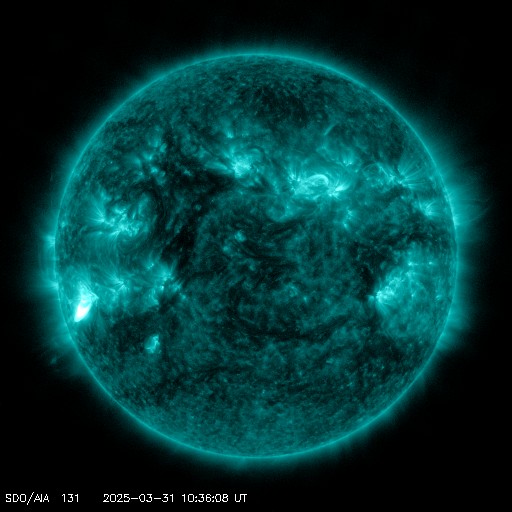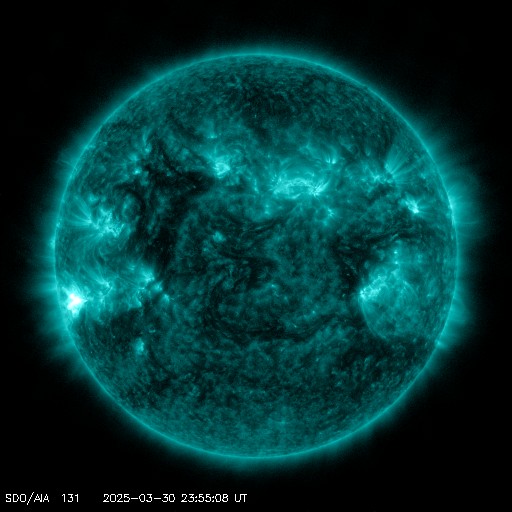Viewing archive of Sunday, 20 May 2001
Solar activity report
Any mentioned solar flare in this report has a scaling factor applied by the Space Weather Prediction Center (SWPC). Because of the SWPC scaling factor, solar flares are reported as 42% smaller than for the science quality data. The scaling factor has been removed from our archived solar flare data to reflect the true physical units.
Report of Solar-Geophysical Activity 2001 May 20 2200 UTCPrepared by the NOAA © SWPC and processed by SpaceWeatherLive.com
Joint USAF/NOAA Report of Solar and Geophysical Activity
SDF Number 140 Issued at 2200Z on 20 May 2001IA. Analysis of Solar Active Regions and Activity from 19-2100Z to 20-2100Z
Solar activity was high. Two highly impulsive M-class
flares occurred during the period. Both were optically uncorrelated.
The first was an M6 flare at 20/0603 UTC, with an accompanying Type
II radio sweep (1200 km/s) and a 360 sfu 10 cm radio burst. EIT
imagery shows that this event originated over the southwestern limb
and was probably from Region 9455 (S17W90+). An impressive coronal
mass ejection (CME) in conjunction with the flare can be seen on
images from the LASCO/SOHO spacecraft. The CME appears to be non
earth-directed. An M1 flare with an accompanying Type II radio sweep
(1088 km/s) was detected at 20/0920 UTC. This event was most likely
a backside event from the same region as the previously described M6
event. Region 9463 (N09E46) nearly doubled in size and spot count
overnight and also developed into a more complex sunspot group
classification (14 spot, Eko-Beta). Region 9465 (S08E63) was
numbered as it rotated onto the disk, already showing a 4 spot
Dao-Beta sunspot classification.
IB. Solar Activity Forecast
Solar activity is expected to be low
to moderate. Regions 9461 (N22E10) and 9463 are both capable of
producing isolated M-class events.
IIA. Geophysical Activity Summary 19-2100Z to 20-2100Z
The geomagnetic field was at quiet to unsettled levels. The greater than 10 MeV proton flux at geosynchronous orbit became enhanced following today's M6 flare, but did not reach event criteria. The greater than 2 MeV electron flux at geosynchronous
orbit reached moderate levels during the period.
IIB. Geophysical Activity Forecast
The geomagnetic field is
expected to be mostly quiet to unsettled for the first two days of
the forecast period. Isolated active conditions may occur on the
third day due to a potentially favorably positioned coronal hole and
the subsequent high speed stream impacting earth. The greater than 2
MeV electron flux and greater than 10 MeV proton flux at
geosynchronous orbit should continue to be at elevated levels for
the first half of the period and then can expected to return to near
background levels.
III. Event Probabilities 21 May to 23 May
| Class M | 30% | 30% | 30% |
| Class X | 01% | 01% | 01% |
| Proton | 01% | 01% | 01% |
| PCAF | green | ||
IV. Penticton 10.7 cm Flux
Observed 20 May 142 Predicted 21 May-23 May 140/140/140 90 Day Mean 20 May 168
V. Geomagnetic A Indices
Observed Afr/Ap 19 May 010/012 Estimated Afr/Ap 20 May 008/012 Predicted Afr/Ap 21 May-23 May 008/012-008/012-015/015
VI. Geomagnetic Activity Probabilities 21 May to 23 May
| A. Middle Latitudes | |||
|---|---|---|---|
| Active | 20% | 20% | 25% |
| Minor storm | 05% | 05% | 10% |
| Major-severe storm | 01% | 01% | 01% |
| B. High Latitudes | |||
|---|---|---|---|
| Active | 25% | 25% | 35% |
| Minor storm | 10% | 10% | 15% |
| Major-severe storm | 01% | 01% | 01% |
All times in UTC
Current data suggests there is a slight possibility for aurora to appear at the following high latitude regions in the near future
Whitehorse, YTAnchorage, AK, Fairbanks, AK, Juneau, AK, Utqiagvik, AK
Latest news
Latest forum messages
Unspecified geomagnetic activity 2147AR4048 38AR4046 136Solar Demon 3Aurora photography hints for those of us with smartphones 54
More topicsSupport SpaceWeatherLive.com!
A lot of people come to SpaceWeatherLive to follow the Sun's activity or if there is aurora to be seen, but with more traffic comes higher server costs. Consider a donation if you enjoy SpaceWeatherLive so we can keep the website online!

Latest alerts
11:15 UTC - Solar protons
Minor S1 Solar Radiation Storm - Minor impacts on HF radio through polar regions
10:45 UTC - Solar flare
Moderate M1.26 flare
10:27 UTC - Radio Blackout
Minor R1 radio blackout in progress (≥M1 - current: M1.22)
00:09 UTC - Solar flare
Moderate M1.03 flare
Sunday, 30 March 2025
23:51 UTC - Radio Blackout
Minor R1 radio blackout in progress (≥M1 - current: M1.03)
Space weather facts
| Last X-flare | 2025/03/28 | X1.1 |
| Last M-flare | 2025/03/30 | M1.0 |
| Last geomagnetic storm | 2025/03/27 | Kp5 (G1) |
| Spotless days | |
|---|---|
| Last spotless day | 2022/06/08 |
| Monthly mean Sunspot Number | |
|---|---|
| February 2025 | 154.6 +17.6 |
| March 2025 | 127 -27.6 |
| Last 30 days | 127 -25.7 |




